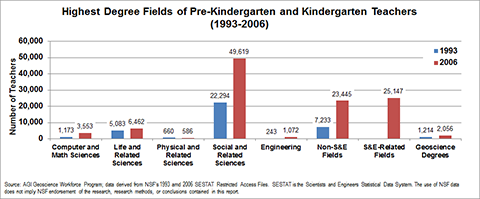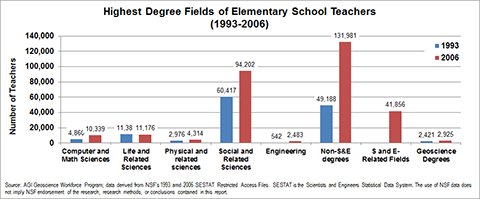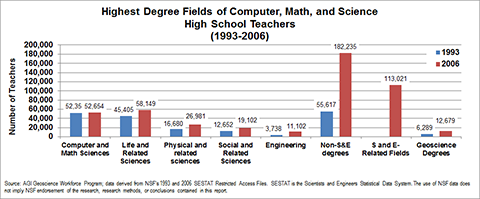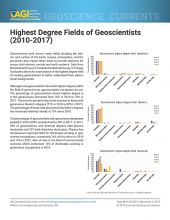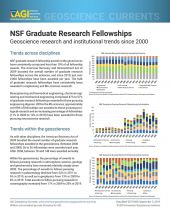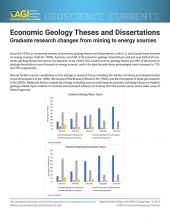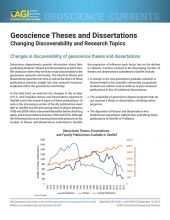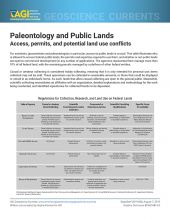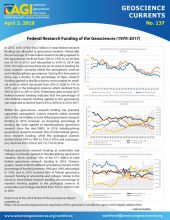K-12 education provides an important formative stage in a student’s education, and the coursework to which students are exposed during this period (especially during high school) influences choices they make in regards to college majors. Examination of national trends in degrees of K-12 teachers between 1993 and 2006 indicates a low representation of teachers with geoscience degrees. In pre-kindergarten and elementary school, teachers most commonly have their highest degrees in the social sciences or in non-science and engineering disciplines. However, whereas in pre-kindergarten and kindergarten the percentage of teachers with their highest degree in the geosciences is between 2-3 percent, in elementary school it is only 1-2 percent.
Highest degree fields of pre-kindergarten and kindegarten teachers (1993-2006). Source: AGI Geoscience Workforce Program, data derived from NSF's 1993 and 2006 SESTAT Restricted Access files.
Note: The inclusion of "S&E related fields" as a degree category in 2006 is a primary factor in the decline in the number of degrees from other fields from 1993 to 2006. The "S&E Related fields" category includes Health, Science and Math Teacher Education, Technology and Technology Fields, and Other S&E Related fields.
In secondary school, the most common degree fields of computer, math, and science teachers are relatively evenly split between computer and math sciences, life sciences, and non-science and engineering degrees. Approximately 3 percent of these secondary school computer, math, and science teachers have their highest degree in the geosciences. In 2006, 12,679 secondary school computer, math, and science teachers had their highest degree in the geosciences.
Highest degree fields of elementary school teachers (1993-2006). Source: AGI Geoscience Workforce Program, data derived from NSF's 1993 and 2006 SESTAT Restricted Access files.
Note: The inclusion of "S&E related fields" as a degree category in 2006 is a primary factor in the decline in the number of degrees from other fields from 1993 to 2006. The "S&E Related fields" category includes Health, Science and Math Teacher Education, Technology and Technology Fields, and Other S&E Related fields.
In a related survey, the Council of Chief State School Officers reported a total of 322,907 secondary school math and science teachers for the year 2006. Of that number, only 16,211 were Earth Science Teachers, 74 percent (or 12,320) of which were assigned to the subject in one or more periods and had state certification in the subject.
Considering that earth science education requirements are met by the majority of students in grades 6-8, the low representation of elementary school teachers with geoscience degrees is cause for concern in regards to the preparation of elementary students for mandatory earth science curriculum in the middle grades, and for priming their interest to take earth science courses in the higher grades. In secondary school, earth science is not required for graduation in most states and there are fewer earth science teachers than in other disciplines. As a result, high school students are less likely to take earth science courses in high school. Furthermore, Holbrook’s 1997 study1 indicated that low enrollments in geoscience undergraduate programs are linked to the lack of exposure high school students have to earth science curriculum. Increasing the cadre of well-trained K-12 teachers with geoscience degree backgrounds is important for bolstering the influx of students into geoscience degree programs.
Highest degree fields of computer, math, and science secondary school teachers (1993-2006). Source: AGI Geoscience Workforce Program, data derived from NSF's 1993 and 2006 SESTAT Restricted Access files.
Note: The inclusion of "S&E related fields" as a degree category in 2006 is a primary factor in the decline in the number of degrees from other fields from 1993 to 2006. The "S&E Related fields" category includes Health, Science and Math Teacher Education, Technology and Technology Fields, and Other S&E Related fields.
References:
1Holbrook, J. Career Potential in the Sciences, Geology in the High Schools, and Why Anyone Would Major in Geology Anyway. Palaios 1997, 12, 503–504.
View an in-depth discussion of this information in the corresponding Geoscience Currents Discussion Webinar.


